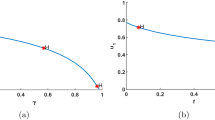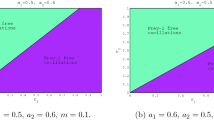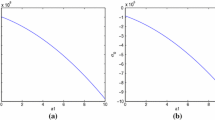Abstract
Experiments show that the fear of predators reduces the birth rate of the prey population, but it does not cause the extinction of the prey population. Even if the fear is sufficiently large, the prey can survive under the saturated fear cost. Moreover, the sensitivity of prey to predator will affect the population density of prey and predator. It is feasible to introduce the saturated fear cost and predator-taxis sensitivity into the predator–prey interactions model. In this paper, we obtain the threshold condition of the persistence for the proposed model and discuss all ecologically feasible equilibrium points and their stability in terms of the model parameters. Furthermore, when choose the fear level as bifurcation parameter, the model will arise single Hopf bifurcation point. However, when choose the predator-taxis sensitivity as bifurcation parameter, the model will arise two Hopf bifurcation points. In order to determine the stability of the limit cycle caused by Hopf bifurcation, the first Lyapunov number is calculated in detail. In addition, by the sensitivity analysis and the elasticity analysis, the saturated fear cost takes on the strong impact on the sensitivity for the model, and the predator death rate has a greater impact on the persistence of the model than the prey death rate. Our numerical illustration also shows that the predator-taxis sensitivity determines the success or failure of the predator invasion under appropriate fear level.







Similar content being viewed by others
References
Levin, S.A.: Dispersion and population interactions. Am. Nat. 108(960), 207–228 (1974)
Berryman, A.A.: The orgins and evolution of predator–prey theory. Ecology 73(5), 1530–1535 (1992)
Murray, J.D.: Mathematical Biology I: An Introduction. Springer, New York (2002)
Cantrell, R.S., Cosner, C.: On the dynamics of predator–prey models with the Beddington–DeAngelis functional response. J. Math. Anal. Appl. 257(1), 206–222 (2001)
Kuang, Y.: Rich dynamics of Gause-type ratio-dependent predator–prey system. Fields Inst. Commun. 21, 325–337 (1999)
Fan, M., Wang, Q., Zou, X.: Dynamics of a non-autonomous ratio-dependent predator–prey system. Proc. Roy. Soc. Edinb. A Math. 133(1), 97–118 (2003)
Hsu, S.B., Hwang, T.W., Kuang, Y.: Global dynamics of a predator–prey model with Hassell–Varley type functional response. Discrete Cont. Dyn. B 10(4), 857–871 (2008)
Liu, J., Liu, B., Lv, P., Zhang, T.: An eco-epidemiological model with fear effect and hunting cooperation. Chaos Solitons Fractals 142, 110494 (2021)
Preisser, E.L., Bolnick, D.I.: The many faces of fear: comparing the pathways and impacts of nonconsumptive predator effects on prey populations. PLoS ONE 3(6), e2465 (2008)
Maerz, J.C., Panebianco, N.L., Madison, D.M.: Effects of predator chemical cues and behavioral biorhythms on foraging, activity of terrestrial salamanders. J. Chem. Ecol. 27(7), 1333–1344 (2001)
Creel, S., Christianson, D.: Relationships between direct predation and risk effects. Trends Ecol. Evol. 23(4), 194–201 (2008)
Cresswell, W.: Predation in bird populations. J. Ornithol. 152(1), 251–263 (2011)
Pangle, K.L., Peacor, S.D., Johannsson, O.E.: Large nonlethal effects of an invasive invertebrate predator on zooplankton population growth rate. Ecology 88(2), 402–412 (2007)
Altendorf, K.B., Laundré, J.W., López González, C.A., Brown, J.S.: Assessing effects of predation risk on foraging behavior of mule deer. J. Mammal. 82(2), 430–439 (2001)
Wang, X., Zanette, L., Zou, X.: Modelling the fear effect in predator–prey interactions. J. Math. Biol. 73(5), 1179–1204 (2016)
Zanette, L.Y., White, A.F., Allen, M.C., Clinchy, M.: Perceived predation risk reduces the number of offspring songbirds produce per year. Science 334(6061), 1398–1401 (2011)
Sarkar, K., Khajanchi, S.: Impact of fear effect on the growth of prey in a predator–prey interaction model. Ecol. Complex. 42, 100826 (2020)
Sasmal, S.K., Takeuchi, Y.: Dynamics of a predator–prey system with fear and group defense. J. Math. Anal. Appl. 481(1), 123471 (2020)
Gard, T.C., Hallam, T.G.: Persistence in food webs-I Lotka–Volterra food chains. Bull. Math. Biol. 41(6), 877–891 (1979)
Khajanchi, S.: Uniform persistence and global stability for a brain tumor and immune system interaction. Biophys. Rev. Lett. 12(04), 187–208 (2017)
Verhulst, F.: Differential Equations and Dynamical Systems. Henri Poincaré. Springer, Boston, MA (2012)
Banerjee, M., Volpert, V.: Spatio-temporal pattern formation in Rosenzweig–Macarthur model: effect of nonlocal interactions. Ecol. Complex. 30, 2–10 (2017)
Panday, P., Pal, N., Samanta, S., Tryjanowski, P., Chattopadhyay, J.: Dynamics of a stage-structured predator–prey model: cost and benefit of fear-induced group defense. J. Theor. Biol. 528, 110846 (2021)
Tripathi, J.P., Meghwani, S.S., Thakur, M., Abbas, S.: A modified Leslie–Gower predator–prey interaction model and parameter identifiability. Commun. Nonlinear Sci. 54, 331–346 (2018)
Acknowledgements
The work is partially supported by the National Natural Science Foundation of China (Nos. 11975025, 12011530158); the Natural Science Foundation of Anhui Province of China (No. 2108085MA10); and the Key Project of Natural Science Research of Anhui Higher Education Institutions of China (Nos. KJ2020A0491, KJ2020A0492, KJ2019A0556).
Author information
Authors and Affiliations
Corresponding author
Additional information
Publisher's Note
Springer Nature remains neutral with regard to jurisdictional claims in published maps and institutional affiliations.
Rights and permissions
About this article
Cite this article
Dong, Y., Wu, D., Shen, C. et al. Influence of fear effect and predator-taxis sensitivity on dynamical behavior of a predator–prey model. Z. Angew. Math. Phys. 73, 25 (2022). https://doi.org/10.1007/s00033-021-01659-8
Received:
Revised:
Accepted:
Published:
DOI: https://doi.org/10.1007/s00033-021-01659-8




